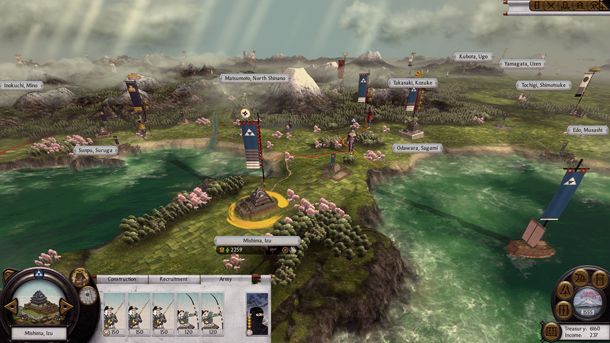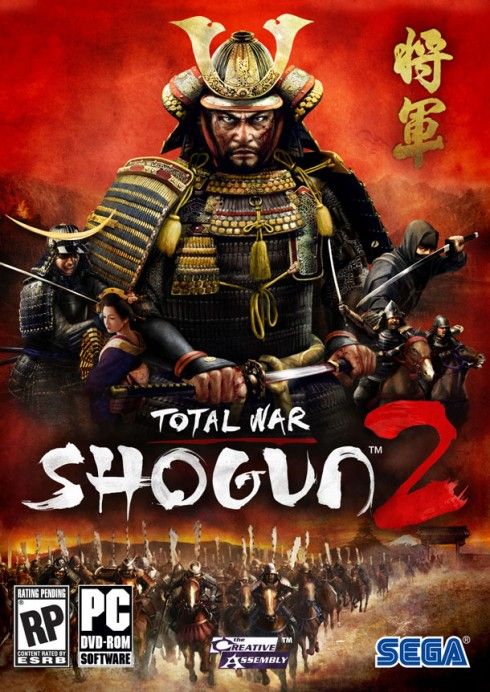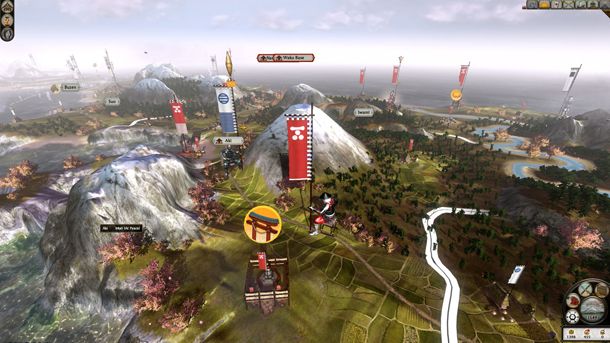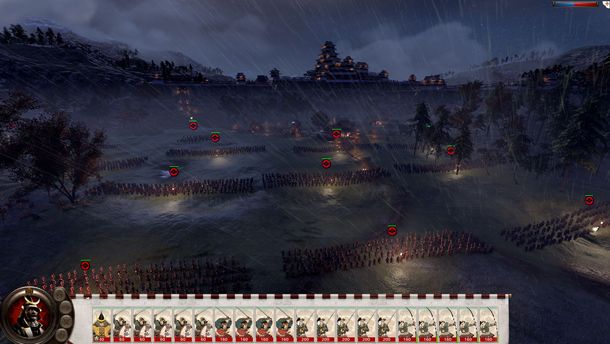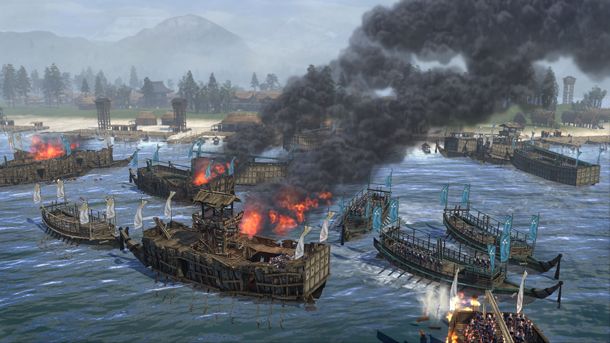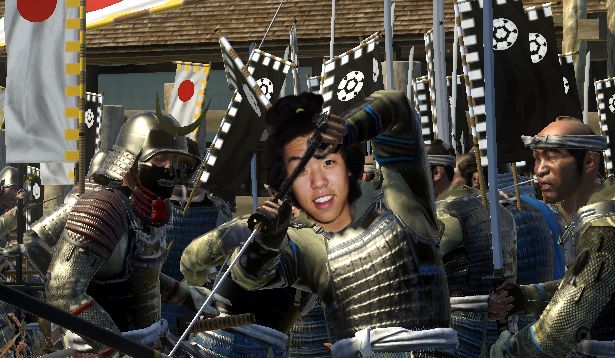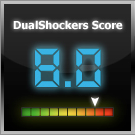The Total War series has always been in something of a class of its own. They're the kind of games you will only see on the PC platform, and that alone is enough to earn them a very devoted following. It all began more than ten years ago with the release of the first Total War: Shogun in 2000, and developer The Creative Assembly has decided that it's time to return to their roots and make a proper follow-up to their first groundbreaking project with Total War: Shogun 2.
Yes, it's a series with a long and storied history, and one that most PC devotees know quite well. That's what makes it so odd that Shogun 2 is actually my first foray into Total War. So how kind is this iteration for newcomers? Is the accumulated knowledge of ten years and hundreds of campaigns necessary to become Shogun? Hit the jump and we'll find out.
If you're not familiar with the basic premise of the game, here's a quick rundown: it drops you waist-deep into war torn 16th century Japan and puts you in control of one of nine of Japan's most powerful clans as they compete with each other to become the Shogun, Japan's singular military ruler. It plays out in a somewhat Risk-style board game format, with you deploying your armies to capture the provinces of your opponents, and doing battle on land or sea, ultimately seeking to capture the capitol city of Kyoto.
The goal is simple, but the means of execution are many. Each of the possible clans has unique strengths that encourage particular means of defeating your enemies, whether that's through diplomacy, subterfuge, or all-out warfare. For example, the Hojo clan can build more durable structures on the cheap, and are capable of building great siege weaponry for taking down the structures of their opponents. But maybe you like boats more, so you'd prefer to play as the Mori clan, who's ships are second to none. Combined with the different starting locations for each clan, you've got a pretty different campaign experience depending on which clan you decide to lead to victory.
Progression on the main campaign map takes place on a turn-based system, where you're given all the time you need to manage the buildings in your cities, recruit troops, move your armies, or engage in diplomatic relations with another clan. In addition to combat units, you can also recruit specialty units called "agents", such as ninja or monks, that provide bonuses to towns or can deployed to sabotage your enemies. The number of options available to you at any given time during your turn is usually pretty staggering. Especially once you get a couple provinces under your belt, managing all of your cities, armies, navies, and agents, can be borderline overwhelming. On top of managing each of those, each of your army's generals and all of your agents have individual, RPG-style progression as they gain experience, giving them various bonuses in or out of combat.
Yes, the task of becoming the Shogun is far from simple, and it can be easy of losing track of exactly how that's going to get done, especially when one single player campaign can last easily ten to fifteen hours. Fortunately, Shogun 2 does a good job of breaking things down into more manageable chunks for you to tackle one at a time. It does this in two main ways: the Arts tree and Missions. The Arts tree will look pretty familiar to anyone who has had experience with strategy games: it's effectively a tech tree, broadly separated into "Bushido" and "Chi", basically combat and non-combat arts. Study of Bushido arts will enable the building of more advanced unit-producing structures in your cities, while advancing your Chi arts will allow you to upgrade things like farms and roads, or improve the performance of your various agents.
Missions are smaller objectives (taking a specific province or mastering a specific art, for instance) that typically only take a few turns to complete, for which you'll be rewarded some extra units or a temporary buff of some kind. The actual gameplay impact of the rewards is not particularly significant, but the missions serve to provide you with shorter milestones and clearer goals towards which you can work, which is an immense help during those periods in your campaign where they may be relatively little happening and you may be at a loss for how to progress.
As overwhelming as the clan macro-management can get, Shogun 2 provides a couple pretty robust features to ease you into it. First is your basic tutorial, which walks you step by step through the opening of a typical campaign, including example ground and sea battles, with everything clearly explained and demoed with full voice over. And if you ever get confused after that (and you probably will), the game also includes an incredibly detailed in-game encyclopedia which you can access at any time. It's basically a game manual for the modern gaming era; a Wikipedia-esque database (in fact, it's actually coded in HTML and launches in a tiny browser within the game) that allows you to peruse every detail about everything in the game. Any time you're confused about anything, simply hit the encyclopedia button next to that object, and you'll immediately pull up the page associated with it so you can learn more than you'll probably ever need to know. It's an incredibly thoughtful inclusion, and keeps you from running off to find a guide on the internet any time you get flustered.
Of course, dictating your clan's actions on the campaign map is really only half the game. The other half will have you taking direct control of the men in your army on the battlefield. In these skirmishes, you'll be moving and battling with your units in a fashion much like other real-time strategy games, though it's in these comparisons that Shogun 2's real-time battling system falls short. As is evident in the rest of the game, the folks at The Creative Assembly have a fanatical devotion to the accurate portrayal of this time period, and as such, the combat itself stays very true to what would have happened at the time. In other words, it's a lot of angry Japanese dudes screaming at each other as they charge headlong into flying arrows, hoping they manage to get their goofy curve-style swords to connect with something besides dirt. It's chaotic and it's tough to control, is what I'm saying. If you're used to the fast, precise micromanagement that's possible in a game like Starcraft or Command and Conquer, trying to convince your regiment of archers to get into formation along the top of a hill will feel like trying to herd a bunch of overweight cats.
Nautical combat doesn't fare much better, as it usually comes down "who can kite the big ships with the little ships longer", until the big ships catch somebody and you have to watch the slow, brutal boarding and sacking process unfold in real time. Fortunately, it seems as though The Creative Assembly knew that battles could be potentially sluggish, and included a fast forward button to the battle interface for your convenience. For me, though, it seems like if you're just going to spend the battle in fast forward, you may as well use the "auto-resolve battle" option and avoid the whole business to begin with.
It's a shame that the real-time battles aren't more enjoyable, because Shogun 2's multiplayer modes are pretty heavily dependent on them. There are co-operative and head-to-head campaigns, which are fairly self-explanatory, but Avatar Battle, in particular, is something I wish I could appreciate more, because the PvP progression on display seems pretty awesome. Basically, it presents you with a customizable clan on a simplified version of the campaign map, and you move your army pieces around and do battle with other players to take new areas that unlock more units. Any time you do something, your avatar gains experience to unlock various perks and benefits, allowing for lots of interesting options and army compositions. It all seems very sleek and intelligently designed, but unfortunately, all the actual combat is the aforementioned molasses-covered feline rodeo, and will therefore appeal only to the very devoted or the very patient. The option to create clans with your friends and take on pre-made teams of opponents also exists in this mode, but as of this writing I have never successfully gotten a game to start using this method.
In fact, the online in general feels a little broken right now. There is some Steamworks integration for friends lists and achievements, but it's definitely not as robust as most Steam users are used to. Joining friend games via your Steam friends list is not very stable, and I've heard fairly widespread complaints about dropped connections to games. Hopefully this is something that Sega and The Creative Assembly are in the process of fixing, because the servers currently seem pretty barren.
If you want it to, Shogun 2 will definitely push the limits of your machine. While it does scale pretty well for weaker computers, and the minimum specs are very reasonable, when you can really get things running on all cylinders, you will absolutely be rewarded. As you've been able to see from the screenshots, the visuals can be extremely breathtaking. On a technical level, the number of individual models being animated at one time is astounding, especially in the ground battle scenes. The campaign map screen is way more detailed than it has any right to be; each passing turn changes the season, and tiny people can be seen traveling along roads and trade routes just to make the world feel alive. The art style just breathes love for the Japanese aesthetic; everything is presented with incredibly authentic Japanese calligraphy and woodblock prints in the style of the period.
Love for the culture doesn't stop with the visuals. The Creative Assembly have really gone out of their way to make every element of this game feel authentically Japanese, and authentically period. It even goes so far as to imbue the strategy gameplay with the culture and philosophy that characterized that era, particularly using Sun Tzu's The Art of War as a central basis for the way the opponents play the game. The specifics for how that happens are kind of opaque, but what is clear is that it encourages the use of policies and tactics that, through the lens our modern, western sensibilities, seem downright odd. For example, members of your clan's royal family can be used as bargaining chips in diplomatic relations, and the somewhat abstract concept of "honor" is highly valuable. Your clan leader, or Daimyo, has an Honor rating that determines the loyalty of his generals. If it gets too low through the use of dishonorable tactics, like the razing of cities or the betrayal of allies, you may find that your prized generals turn against you. The fact that details like this exist in the game shows that there was an incredibly deep understanding of the culture and history of this period on the part of the developers, and when everything is said and done, it really makes you feel like the Shogun.
So if you're like me, and this is your first time with a Total War game, Shogun 2 might be a good place to start. It can feel extremely punishing at first, but if you make use of the helpful resources available to you, and you stick it out through what can feel like simple trial and error, you'll end up with an extremely deep, rewarding experience. The fact that the battle system is sub-par is unfortunate, as is the somewhat lackluster multiplayer, but considering the breadth of the content available here, is not actually as much of a detriment as it might seem. And if you're willing to stick it out and enjoy those battles, this game is really the complete package.
-
Title: Total War: Shogun 2
- Platform Reviewed: PC
- Developer: The Creative Assembly
- Publisher: Sega
- MSRP: $49.99
- Release Date: March 15, 2011
- Review Copy Info: A review code of the title was provided to DualShockers Inc. by the publisher for the purpose of this review.
Total War: Shogun 2
- Platform(s)
- PC
- Developer(s)
- Creative Assembly
- Publisher(s)
- Sega
- Genre(s)
- Strategy

